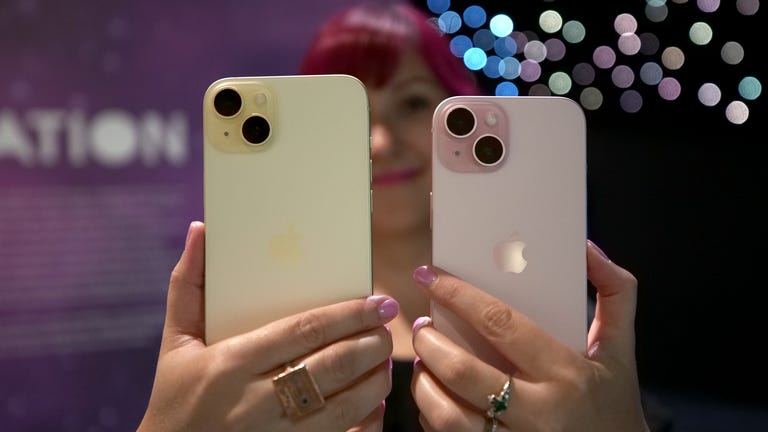Thinking about buying the iPhone 15? If your phone is still in good condition, it can be difficult to decide whether it’s worth upgrading or hanging onto your current device.
I spent weeks using the iPhone 15 as my primary phone last fall. In that time, I found it to be a big step up from my aging iPhone 12 — as I wrote in my initial review and my one-month follow-up.
The addition of USB-C and the Dynamic Island make the iPhone 15 feel more convenient in a lot of ways. You no longer have to carry multiple cables to charge your phone and your non-Apple devices, and the Dynamic Island makes it easier to see time-sensitive information — like your Uber’s ETA — without flipping between apps. The new 48-megapixel camera also takes more detailed photos, and the iPhone 15’s fresh design has a matte finish that’s more resistant to fingerprint smudges.
While these changes come together in a way that makes the iPhone 15 feel truly new, iPhone 14 and iPhone 13 owners should hold off on upgrading. Both phones still have plenty of life left in them, so the differences in general performance and camera quality won’t feel as monumental as they would coming from an older phone.


The iPhone 14 is new enough that we recommend waiting before you upgrade.
The iPhone 15 brings numerous upgrades over the iPhone 14, making it a larger leap than the jump from the iPhone 13 to the iPhone 14.
A new USB-C charging port replaces the Apple-specific Lightning connector, the main camera sensor has a significantly higher resolution, and the Dynamic Island sits where the notch used to be. Plus, you’ll get an upgrade to the same A16 Bionic processor found inside the iPhone 14 Pro, and the iPhone 15 has an eye-catching new design with a matte finish. The screen is also brighter compared to last year’s iPhone 14.
But since the iPhone 14 is only a year old, I’d recommend waiting before upgrading. While a universal USB-C charging port and the Dynamic Island certainly add more convenience to the iPhone, they’re not enough to convince most people to upgrade.
The new 48-megapixel camera is a step up from the 12-megapixel system on the iPhone 14, but the improvements will be more noticeable coming from a phone that’s more than two years old. If you primarily view and share photos on your phone rather than printing them or displaying them on a larger screen, the previous-generation 12-megapixel camera will do just fine.
The Dynamic Island, USB-C and the upgraded camera are the iPhone 15’s biggest changes. But for most people, these features likely aren’t enough to justify shelling out $799. Carrier deals may knock that price down significantly, but those discounts are often only available under certain conditions, such as adding a new line.
The bottom line: You can hang onto your iPhone 14 for now. While it’s great to see more dramatic upgrades than last year, the iPhone 14 still has plenty of life in it. That’s especially true if you have the iPhone 14 Pro. The iPhone 15 has a lot in common with the iPhone 14 Pro, and it lacks the Pro’s dedicated telephoto lens, always-on display, stainless steel body and high refresh rate.
iPhone 15 vs. iPhone 13

The iPhone 12 is probably due an upgrade now.
If you own an iPhone 12, the decision about whether you should upgrade is more complicated. Phones older than the iPhone 12 are a no-brainer upgrade, and newer models are worth hanging onto for a bit longer (unless you can snag a great trade-in deal). But the iPhone 12 falls in the middle. You can get more mileage out of it, but it’s also old enough to justify an upgrade.
Compared to the iPhone 12, the iPhone 15 has the Dynamic Island, a processor that’s two generations newer, a much-improved camera with a higher resolution main sensor, longer battery life, car crash detection, emergency SOS via satellite, a brighter screen, extra camera modes, double the storage at the base level and longer battery life. That’s a lot.
If you’re happy with your iPhone 12 and don’t want to part with it until you absolutely have to, that time hasn’t come just yet. Since the iPhone 12 supports 5G and is compatible with new software upgrades like iOS 17, you can hold onto it for a little while longer.
But if you bought your iPhone 12 at launch, it’s probably starting to feel sluggish and the battery life is likely starting to drain more quickly. As an iPhone 12 owner, I can say I’m experiencing those symptoms myself. The upgrades to general performance and camera quality are also very apparent when switching from the iPhone 12, as I wrote in my review. The amount of detail I was able to capture when shooting portraits on the iPhone 15 compared to the iPhone 12 was particularly noticeable.
The bottom line: It’s worth upgrading to the iPhone 15 if you have an iPhone 12. The updates go beyond new technologies like the Dynamic Island and USB-C; you also get a notable upgrade in everything from general performance to battery life and camera quality. However, if you don’t want to upgrade just yet, Apple still supports the iPhone 12 with new software updates.
iPhone 15 vs. iPhone 11

The iPhone XS is old enough to attend kindergarten.
The iPhone XS is five years old, and its age is showing. Upgrading to the iPhone 15 will not only mean getting access to new features, but you’ll also experience significantly longer battery life, a larger screen and 5G network speeds.
The iPhone XS has most of the same shortcomings as the iPhone 11, which includes the omission of 5G, no MagSafe support and an older, lower-resolution 12-megapixel camera. But on top of all that, the iPhone XS has a chip that’s four generations old, a 5.8-inch screen that’s smaller than the iPhone 15’s 6.1-inch display, a lower-resolution selfie camera (7 megapixels compared to 12 on the iPhone 15) and no night mode for taking photos in the dark.
The iPhone XS does have a dedicated telephoto camera, unlike the iPhone 15, which instead has an ultrawide lens as its secondary camera. But it’s a worthy sacrifice since you’ll be gaining all of the other camera upgrades Apple has added to the iPhone in recent years, which are sure to make a difference. If I noticed a major improvement coming from the iPhone 12, it’s safe to say the difference between the iPhone 15 and iPhone XS is bound to be significant.
Night mode is just the beginning. You’ll also get a major boost in general image quality thanks to the improved image processing that comes from Apple’s new chips, along with an ultrawide-angle camera for wider shots, Action mode for improved video stabilization, Cinematic mode, which records video with a shallow depth of field, and much more.
And that’s just the camera. General performance will likely seem faster, and battery life will last longer. On top of all that, you’ll also get the Dynamic Island and USB-C.
The iPhone XS generation is also the oldest iPhone to support iOS 17, meaning there’s a chance your phone won’t support next year’s upgrade. The same advice applies if you’re upgrading from the iPhone XR, which launched alongside the XS in 2018 and shares many of its characteristics, including the old A12 Bionic processor. The iPhone XR was essentially the budget version of the iPhone XS, seeing as it launched at a cheaper price and lacks the XS’ telephoto camera, OLED screen and stainless steel design.
The bottom line: Yes, it’s definitely worth upgrading if you have the iPhone XS or iPhone XR. Apple has upgraded the iPhone significantly in just about every way over the last five years.
iPhone 15 vs. Older iPhones

